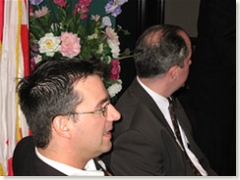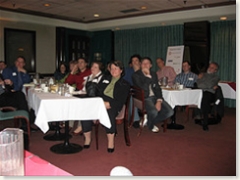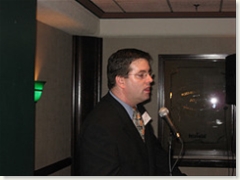 Colin McKay and Ian Ketcheson talk at Third Tuesday Ottawa [ 10:51 ] Play Now | Play in Popup | Download
Colin McKay and Ian Ketcheson talk at Third Tuesday Ottawa [ 10:51 ] Play Now | Play in Popup | Download Colin McKay is one smart guy and as experienced as they come in social media. He’s been blogging as Canuckflack since 2003. Earlier this year, he launched a second blog, SoSaidtheOrganization, focusing on government communications and social media.
Colin McKay is one smart guy and as experienced as they come in social media. He’s been blogging as Canuckflack since 2003. Earlier this year, he launched a second blog, SoSaidtheOrganization, focusing on government communications and social media.
Colin also has a day job as the Acting Director of Communications at the Office of the Privacy Commissioner of Canada. And he’s used that position to launch what is arguably the most successful example of a government blog so far in Canada – the Privacy Commissioner’s Blog.
Colin was our guest at Third Tuesday Ottawa last month. During his presentation and in a lengthy question and answer session, he offered a candid view of how he managed to obtain the support to initiate the Privacy Commissioner’s blog and how he sustains it.
How has Colin been successful in introducing blogging and other social media tactics into a government environment that has been slow to embrace social media? His Third Tuesday discussion provided some practical tips and observations based on his experience.
Build a business case
“I’d been spending four years slamming my head against a wall bringing up social media and building some sort of conversation within a much larger department. And I think everyone who’s worked in a bureaucracy realizes at some point or another that there are institutional barriers to social media – fairly strong ones. But what I realized coming into a smaller organization like the Privacy Commissioner … if you enter an organization that has at least one or two people who recognize the benefits of social media, if you build a strong business case … something that drives along a business case model that identifies risk and how you will mitigate risk, you can convince … people to try something new…”
Don’t deny risk. Tackle it head on.
“At the Privacy Commissioner, I don’t have a Minister or a Deputy Minister. I have an Agent of Parliament. That means that my description of risk and my expression of the way that I would mitigate that risk and deal with crises as they evolved did not have to reach the same level of sophistication they would with a normal government department, with a department with far more people, far more issues and the possibility of many more things, either on a policy or a program level, going wrong.”
…
“What you have to be able to do is to say that we’re going to limit our experiment to this environment, to this particular policy, to this particular program and here are the five ways it could go wrong and here are the ways we’re going to kill this experiment if it does go wrong.”
Social media isn’t a stand alone. It’s part of a coherent strategy.
“The first thing I did when I arrived [at the Privacy Commissioner’s Office] was I took a look at what we were doing in terms of communications and marketing and what we doing to reach out to specific audiences and whether we were missing audiences. It seemed to me that we had our stakeholder relations program down pat … and we were speaking to them through our traditional programs. … But we didn’t have any popular aspect and we didn’t have any techniques that would approach people who thought of privacy from a different point of view. …That was my access point to suggest that there are some fairly easy to deploy technologies that will let us communicate with these people in an experimental way.”
Help IT to understand that social software won’t punch holes in security.
“… communicators have to stop taking IT people’s denials and the assertion that the infrastructure needs to remain secure as gospel. … There’s no reason why a department couldn’t host a blog externally and link it to their internally hosted server. There’s no reason why the software can’t be deployed. It’s so easy there are twelve year old Russian boys doing it. If there’s a thirty-five year old man or woman telling you that the IT policies state that you can’t do it because of the integrity of your network, then they’ve got some worries about their network that relate to really poor construction and serious structural weaknesses. In which case, you have to work through your business case with the IT management to make them understand the options available and not depend on your IT people to sell it for you.”
Good things happen.
“I was surprised from the first day we were getting positive comments. We haven’t gotten a lot of comment SPAM. … What has appeared are a lot of supportive messages and a lot of comments like, “I was giving a presentation to my children’s grade school today and I saw your video and I’m going to pass it along to the teacher to show to the class. Which is exactly the sort of ‘home run’ I was hoping for.”
Colin and Third Tuesday host Ian Ketcheson talk about these and other issues in the following highlights audio clip.

 If this isn’t enough to make this event a must-attend for you, I’ll give the final word about Colin to Colin himself. The
If this isn’t enough to make this event a must-attend for you, I’ll give the final word about Colin to Colin himself. The  This past week Canadian Member of Parliament Garth Turner was ejected from the Conservative Party Caucus. His expulsion was linked to his
This past week Canadian Member of Parliament Garth Turner was ejected from the Conservative Party Caucus. His expulsion was linked to his 


 CBC News Online
CBC News Online  The
The  The CBC report contains this explanation by a CF spokesman:
The CBC report contains this explanation by a CF spokesman: Last night, the Prime Minister of Canada’s Podcast popped up on
Last night, the Prime Minister of Canada’s Podcast popped up on 